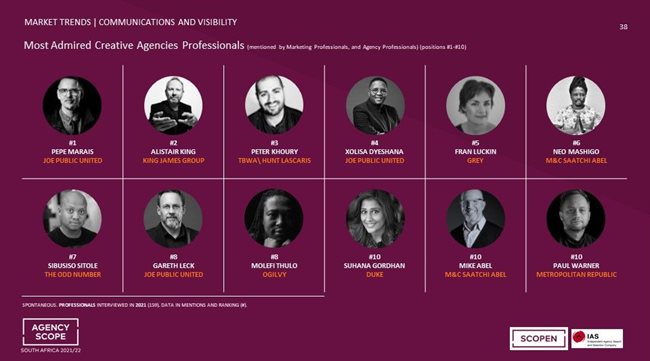The imminent release of Agency Scope 2021/22 - the fourth study South Africa - reveals a profusion of "secrets" from the inner sanctum of marketing and agency leaders.
Eager to share what their organisations have learned since the previous study, 465 interviews disclose the way in which our industries changed, driven by the pandemic, and where we stand in comparison to our foreign counterparts.
Johanna McDowell, CEO of the Independent Agency Search & Selection Company (IAS) and Scopen partner, says an important area that experienced massive change is integration, defined by marketers as having expertise in five different disciplines.
“As we’ve noted in the media, marketers are operating in a much more complex ecosystem, with many working with up to an average of 13 different partners,” she says. “When asked which disciplines marketers take into account in their definition of an integrated agency, almost 100% named digital and advertising, which is largely in line with previous figures.”
McDowell notes that the percentages for the disciplines of PR, Media, Activation and Events decrease in number of mentions, but the rest of the disciplines remain stable from 2019.
President and CEO of Scopen International Cesar Vacchiano says that large companies give more importance to disciplines like ‘relationship marketing’, than other companies when defining an integrated agency. “Conversely, smaller marketers give less importance to activation and sales promotions’ when defining Integration. The evolution of marketing automation and the barriers of COVID for activation are the reasons for these responses.”
To determine the model of integration companies are employing, business leaders surveyed were asked whether they have a lead agency that coordinated their communications requirements.
“Seven out of 10 in South Africa have indeed identified a lead agency to address this need,” says Vacchiano, highlighting that large and medium-sized companies declare the highest percentage, being 75.4% and 70.4% respectively.
“At 69.9%, South Africa is the market with the highest number of marketers that identify one of their agencies as their ‘lead partner’ in Marketing-Communications-Advertising-Media.”
No more silos, say data-reliant business leaders
This leads to an issue that needs attention. “It’s clear that media and creative in some companies operate in silos, each with its own leader. Clients view this as a challenge as they believe integrated data is what business decisions rely on,” he says.
In South Africa, creative agencies are currently undertaking digital transformation to address the issue of data silos, but media agencies are not. “In other countries,” Vacchiano affirms, “we see both creative and media agencies addressing this issue.”
Media agencies appear to be lagging in South Africa and McDowell says this leads to the IAS wondering if media agency margins are so low that they cannot afford the quality tech talent required to drive this transformation.
Food for thought...
As the industry awaits the publication of Agency Scope 2021/22, Vacchiano and McDowell agree that the shining stars of responses to the rigorous examination of industry leaders undertaken by researchers would be the huge growth in the digital sector; and the way in which agencies and clients stepped up during harsh lockdowns and trying conditions to produce work and relationships that are “quite remarkable”, says Vacchiano.
“Client satisfaction with their agencies at this level makes for relationship longevity. Marketers realise that they have strong partnerships with their agencies, who in turn are strong partners for their brands,” he says.
South African marketers are becoming more high profile because of their contribution to the growth of their brands and the work that they are doing, and it is now commonplace for CMOs – and not just their agencies - to be named.
“This makes choosing the best of the best a difficult task, as can be noted in the pictures of most admired creative agency professionals.
“The top ten actually turns out to be the top 12, because the margins between the candidates were so close, it was impossible to choose. And this,” McDowell asserts, “bodes well for the health of our industry.”
































